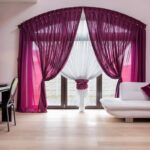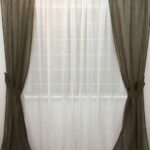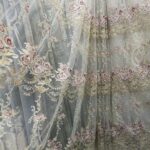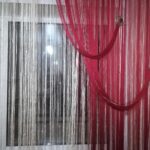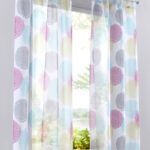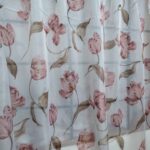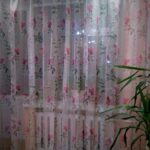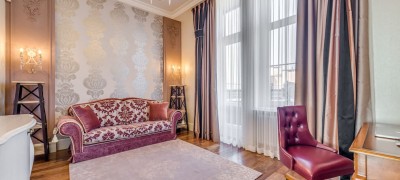Options and selection of colored tulle
Tulle is considered one of the most important elements of a room. Having played it correctly, you can create a unique design, as well as add warmth and harmony to the room. Colored tulle can become not an addition, but a basis. With the help of colors, bright accents are added to the room, which allow the house to "sparkle" in a new way.

Characteristics and types of colored tulle
The main function of colored tulle is considered to be blocking ultraviolet radiation. This type of curtain is able to scatter the sun's rays, so the house immediately becomes light and filled with harmony. The fabric is lightweight so it can be applied to drapery. But, despite the lightness, tulle fixes the appearance well.

Over the past few years, people have shown that heavy curtains or curtains are easily replaced with lightweight tulle. It can be used to create a refined and sophisticated design. For tulle, almost all known colors are used. The main thing is that the color is combined with the rest of the interior. The assortment includes both inconspicuous monochromatic products and bright products with pictures and ornaments.

Before choosing a product, you should think about the theme of the ornament, its relevance in a particular environment. It is important to choose something that can perfectly complement the overall design of the house and demonstrate the owner's sense of style. Also pay attention to the fabric. Tulle can be made from cambric, chiffon, linen and veil.

Tulle rainbow
Tulle rainbow gives extravagance and originality. In most cases, this tulle is chosen to decorate a children's room. Such a solution will help to dilute the boring atmosphere in the house with bright colors and freshness. Additional information: if the colors are arranged vertically, then the room will automatically become taller. On the contrary, a horizontal drawing will make the room larger and wider.

Iridescent tulle is created with both a translucent matte veil and fabric decorated with a small shimmer or shimmer. Choose rainbow tulle if the furniture in the room blends in with the walls and lacks color. If the accessories in the room are multi-colored, then you do not need to add such a curtain, because it will quickly get bored, and children will start to get annoyed with an overabundance of colors.

Monochromatic
Tulle of the same color will perfectly complete the interior, in the design of which there are many decorations, textiles and furniture. Solid and vibrant colors can be diluted with solid tulle. Usually such combinations are created:
- White is used occasionally for fear of quickly getting dirty. Designers are advised to look at light beige, light blue, cream, champagne, gray and powdery colors. If the owner insists on white, you can choose what is decorated with a floral print, geometry or light ornaments.
- You can match the color of the tulle to the upholstery of the sofa.
- Brown tulle suits almost every design, because it is combined with black, green and turquoise.
- Red tulle is said to be chosen for inconspicuous monochromatic "not flashy" furniture.Do not combine a lot of burgundy in one room, over time it will be annoying.
- Lilac and pink tulle gives comfort and peace of mind.
- Purple is always popular because it looks cool with white, yellow, blue, and light gray.
Multicolored
Multicolored tulle is selected according to the same rules as rainbow or striped tulle. The novelty of the season is matte tulle made from a unique mesh. An important advantage of the mesh is its lightness and transparency. The main thing is not to overdo it with shades. Colored nylon tulle from floristry, not organza, will be an excellent solution for the kitchen and the married bedroom.

Striped
The strip was able to be combined with all styles. It is used in vintage designs, loft or minimalism. This solution is designed to deform the geometry of the room. If you choose the right lines, then you can easily remove room flaws, incorrect proportions and volumes. Striped tulle can be in the same calm shades, and in bright saturated colors. Pay attention to the color scheme of the walls, floor and furniture.

Patterned tulle
The drawing can be different. This is geometry, and a floral print, and a chameleon, and animals, and cartoon characters (for the nursery). Choosing patterned tulle, you focus on it. For this reason, give up bright room accessories and unusual furniture. Please note that in this case, the curtain must be without a pattern. On the Internet there are photos of curtains and tulle with daisies in different interiors.

How to choose the right tulle color
There are four guidelines to consider when choosing tulle:
- The shade of the fabric is directly related to the task at hand. If a person wants to complement the room with a bright and variegated highlight, then he chooses a rich and contrasting shade. But in this case, furniture and accessories should be in neutral colors. A pastel tone is chosen for a room in which the furniture is clearly defined.
- If you want to decorate the windows with blackout curtains, then the tulle must be combined with it. But if the curtain is multi-colored, then choose a solid tulle.
- An insert of guipure or openwork creates a modernist style. If you prefer country, then buy materials with natural cotton textures.
- Jewelry such as beads, embroidery, rhinestones and sequins will not be superfluous for a modern style. Proper use can emphasize luxury and add lightness to an austere hi-tech style.
How to paint tulle with your own hands
You may like white tulle again. If the look is a little worn out, then paint the tulle at home. This solution will help you save money, create a unique design with a special combination of shades. There are natural and chemical dyes.

The chemical dye can be from aniline, potassium permanganate or brilliant green. The advantage of the chemical dye is that the color palette is unrealistically wide. Of the shortcomings, they talk about the smell and reaction of the material.
Natural colorants include tea, coffee, vegetables, fruits and herbs. Naturalness and nobility are considered the advantage. Among the disadvantages is a small range of colors and the duration of the process.
- Place the cloth in warm water for 30 minutes. Wash and let dry.
- Choose a color and paint.
- Dilute the paint.
- Put the tulle in the diluted paint. The proportions are usually indicated on the packaging.
- Then rinse and dry.

The right combination of curtains and tulle
The right combination of curtains and tulle is created in the following conditions:
- Light colors will enlarge the room, while dark ones will reduce it.
- For lightweight curtains, choose heavy, blackout curtains.
- Do not take lambrequins for a small and low room.They, of course, emphasize luxury, but also reduce the ceiling.
- Dense materials create small waves. If the tulle is light and translucent, then fold it in several layers.
- Kiseya is a pleasant novelty that can be combined with curtains and light curtains.
When choosing colored tulle, consider all the rules. If everything is done correctly, then the room will turn out to be bright and inspiring.
Video: tulle for window decoration




